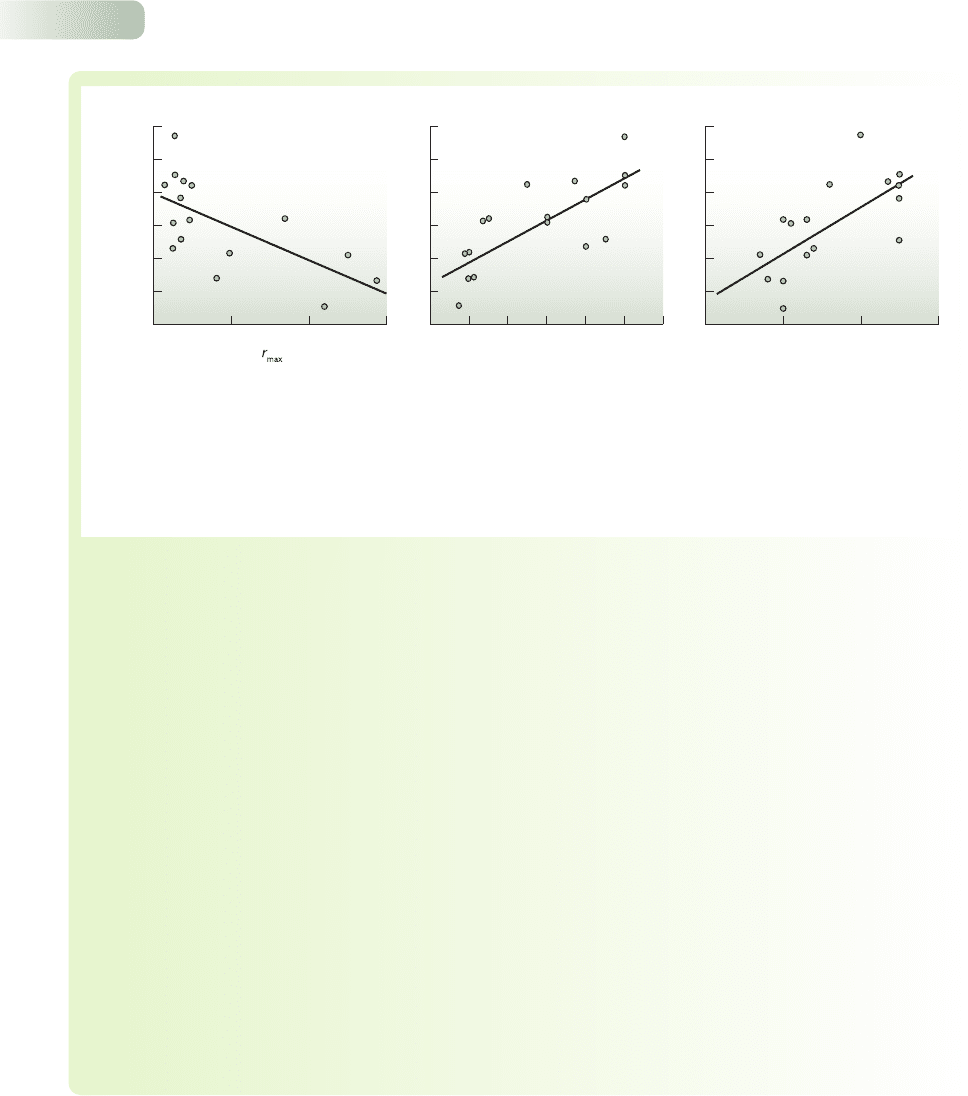Townsend C.R., Begon M., Harper J.L. Essentials of Ecology
Подождите немного. Документ загружается.


the most extreme scenario (an average temperature increase of 2.0°C and a 15%
reduction in rainfall), it is evident that more than half of the species that are
currently restricted to the reserve are predicted to go extinct. A second category
of cacti, whose current ranges are almost equally within and outside the reserve,
are expected to contract their ranges, but in such a way that their distributions
become almost completely confined to the reserve. A final category, whose current
distributions are much more widespread, also suffer range contractions but in
future they are still expected to be distributed within and outside the reserve. In
the case of these cacti, then, the location of the reserve seems to cater adequately
for potential range changes. But how many other nature reserves may turn out to
be in the wrong place?
14.5 Finale
This final chapter has brought together a diversity of environmental problems
(overexploitation, habitat disruption, introduced species, global climate change),
which themselves require us to understand population, community and ecosystem
dynamics. We have seen that the dynamics of endangered species are governed
by a high level of uncertainty; despite this, our knowledge is sometimes sufficient
to safeguard biodiversity.
Nevertheless, there is no room for complacency. We have insufficient know-
ledge and, just as important, insufficient financial resources to protect everything
everywhere. In desperate times, painful decisions have to be made about priorities.
Thus, wounded soldiers arriving at field hospitals in the First World War were
subjected to a triage evaluation: priority 1, those who were likely to survive but
only with rapid intervention; priority 2, those who were likely to survive with-
out rapid intervention; priority 3, those who were likely to die with or without
intervention. Conservation managers are often faced with the same kind of
choices and need to demonstrate some courage in giving up on hopeless cases,
and prioritizing those species and habitats where something can be done.
The spectrum of opinions on conservation is complete. It ranges from the
environmental terrorist, who is prepared to destroy property and put human life
at risk for what is seen as unacceptable exploitation of animals, to the other
extreme of the exploitational terrorist, who is prepared to destroy a rare habitat
just as it is about to achieve protected status. There are zealots on both sides of
the spectrum too. On the one hand, there are the industrialists, fishers, farmers
and foresters who accept none of the conservationist case and are not prepared
to look objectively at the scientific evidence, while, on the other, are the environ-
mental zealots – preservationists who seem unwilling to accept any exploitation
of the natural world, some even pronouncing that fishing or hunting or logging
are intrinsically wrong. The middle ground is occupied by both exploiters and
conservationists whose basic philosophy holds that natural resources can be used,
but this should be in a sustainable and balanced manner. A thorough under-
standing of the principles and applications of ecological science should enable
all to pay healthy regard to the scientific aspects of what, in its broader context,
is very much an ethical, economic and sociopolitical problem. The task for the
next generation of ecologists is to bring their understanding to bear in this
challenging environment.
Chapter 14 Conservation
479
the ‘triage’ approach to
setting priorities
the challenge – taking a
balanced view
9781405156585_4_014.qxd 11/5/07 15:05 Page 479

Part IV Applied Issues in Ecology
480
The scale of the problem
Conservation is the science concerned with increas-
ing the probability that the Earth’s species and
communities (or, more generally, its biodiversity) will
persist into the future. Biodiversity is, at its most
basic, the number of species present, but it can also
be viewed at smaller scales (e.g. genetic variation
within populations) and larger scales (e.g. the variety
of community types present in a region). About
1.8 million species have so far been named, but the
real number is probably between 3 and 30 million.
The current observed rate of extinction may be as
much as 100–1000 times the background rate
indicated by the fossil record.
Endangered species and rarity
A species may be rare in the sense that its geographic
and/or habitat ranges are small or in the sense that
local populations, even where they do occur, are small.
Many species are naturally rare but just by virtue of
their rarity species are not necessarily at risk of extinc-
tion. However, other things being equal, it will be
easier to make a rare species extinct. Some species
are born rare, others have rarity thrust upon them as
a result of the actions of humans.
Threats to biodiversity
The principal causes of decline are overexploitation,
habitat degradation and the introduction of exotic
species. Overexploitation occurs when people harvest
a population (for food or trophies) at a rate that
is unsustainable. Humans adversely affect habitat
in three ways – a proportion of available habitat may
simply be destroyed, or it may be degraded by pollu-
tion, or it may be disturbed by human activities to the
detriment of some of its occupants. Human-caused
introductions of exotic species, which may occur
accidentally or intentionally, have sometimes been
responsible for dramatic changes to native species
and natural communities.
Genetic problems
Rare alleles of a gene may confer no immediate
advantage but could turn out to be well suited to
changed environmental conditions in the future –
small populations that have lost rare alleles through
genetic drift have less potential to adapt. A more
immediate potential problem is inbreeding depression
– when populations are small there is a tendency for
individuals breeding with one another to be related,
and this may lead to reductions in fertility, survivor-
ship, growth rates and resistance to disease.
The extinction vortex
A given population may have been reduced to a very
small size by one or more of the processes described
above, and this may have led to an increased frequency
of matings among relatives and the expression of
deleterious recessive alleles in offspring, leading to
reduced survivorship and fecundity and causing the
population to become smaller still – the so-called
extinction vortex.
Conservation in practice
Much of conservation biology is a crisis discipline con-
cerned with small populations in immediate danger
of extinction. A high level of uncertainty governs the
dynamics of small populations, whereas large popula-
tions can be described as being governed by ‘the law
of averages’. Three kinds of uncertainty or variation can
be identified that are of particular importance to the
fate of small populations: demographic uncertainty,
environmental uncertainty and spatial uncertainty.
Moreover, loss of habitat frequently results not only
in a reduction in the absolute size of a population
but also the division of the original population into a
number of fragments.
Predicting minimum viable population size
Population viability analysis, a simulation modeling
tool, can be used to estimate the minimum population
SUMMARY
Summary
9781405156585_4_014.qxd 11/5/07 15:06 Page 480

Chapter 14 Conservation
481
size of a particular species that should ensure its per-
sistence with an acceptable probability (e.g. greater
than 90%) for a reasonable period (e.g. 100 years).
Armed with such information, managers can work
out the best approach to guard against extinction
(supplementary feeding, predator control, one or
more reserves of appropriate size, etc.)
Selecting protected areas
Given limited funds to purchase protected areas, it
is important to devise priorities so that they can be
evaluated systematically and chosen with care. We
know that the biotas of different locations vary in
species richness, the extent to which the biota is unique
and the extent to which the biota is endangered; one
or more of these criteria could be used to prioritize
potential areas for protection. The principles of island
biogeography theory provide some clues about the
most appropriate shape and disposition of protected
areas. The selection of a network of reserves to optimize
the protection of biodiversity can be performed on the
basis of ‘complementarity’ (selecting at each step the
site that is most complementary to those already
selected in terms of the biodiversity it contains) or
‘irreplaceability’ (defined in terms of the likelihood
of an area being required to achieve specified con-
servation targets).
Global climate change and conservation
Predicted changes to patterns of temperature and
rainfall around the world have important implications
for conservation biology. Changes to environmental
conditions will affect the size and location of habitable
areas of species, whether or not they are currently
at risk of extinction. Moreover, nature reserves may
turn out to be in the wrong places. Models of global
climate change can be used by ecologists to safe-
guard species and communities when planning for
the conservation of individual species or designing
reserve networks.
REVIEW QUESTIONS
Review questions
Asterisks indicate challenge questions
1* Of the estimated 3–30 million species on Earth,
only about 1.8 million have so far been named.
How important is it for the conservation of
biodiversity that we can name the species
involved?
2 Species may be ‘rare’ on three counts: what
are these? From your own experience, provide
examples of three ‘rare’ species and explain
the nature of their rarity.
3* Researchers collected data on the relative
abundance of 16 Peruvian mammal species
in forest areas that contrasted in whether they
were subject to light or heavy hunting by local
people. As an index of vulnerability to hunting
they used the reduction in relative abundance
in the heavily versus lightly hunted areas. This
was plotted against intrinsic rate of population
increase (r
max
), age of first reproduction and
longevity (Figure 14.15). Provide explanations
for the relationships shown in the figure.
Would you expect the variables r
max
, age
of first reproduction and longevity to be
intercorrelated? If so, how? Many species of
large animals have gone extinct in the last
50,000 years. What light do the results of
s
9781405156585_4_014.qxd 11/5/07 15:06 Page 481

Part IV Applied Issues in Ecology
482
this study shed on the possible role of
overexploitation by humans in historical
extinctions? On the basis of these results,
what advice would you give wildlife managers
about conserving mammals in Peruvian
forests?
4 Are there any circumstances where the
intentional introduction of an exotic species
can be considered a good thing because it
enhances biodiversity?
5 Unpredictable temporal variability is a feature
of most ecosystems. How can conservation
biologists allow for such uncertainty when
they devise species management plans?
6 Explain, with examples, how the loss or
introduction of a single species can have
conservation consequences throughout
a whole ecological community.
7 In desperate times, painful decisions have to
be made about priorities. Discuss the ‘triage’
approach to conservation assessment.
List some highly endangered species of
which you are aware and propose priorities
for conservation action. Are any so hopeless
that they should be allowed to go extinct?
8 Discuss the value of zoos and botanical
gardens in nature conservation.
9 Discuss the advantages and limitations of
using population viability analysis tools to
devise species management plans.
10* The famous ecologist of the early 20th century,
A.G. Tansley, when asked what he meant by
nature conservation, said it was maintaining
the world in the state he knew as a child.
From your perspective, as we enter the new
millenium, how would you define the aims of
conservation biology?
s
Age of first reproduction (years) Longevity (years)
0.0 0.5 1.0 1.5 0 0 10 20 30123 456
3
2
1
0
–1
–2
–3
3
2
1
0
–1
–2
–3
3
2
1
0
–1
–2
–3
Change in abundance (abundance
Yavari Miri – abundance Tahuayo)
(a) (b) (c)
h
h
h
h
k
k
k
e
e
e
p
p
p
o
o
o
l
l
l
n
n
n
m
m
m
i
i
i
j
jj
d
d
d
c
c
c
a
a
a
bb
b
g
g
g
f
f
f
Figure 14.15
Relationships between (a) r
max
, (b) age of first reproduction, and (c) longevity and the vulnerability of mammals to population declines
measured as the change in abundance between lightly and heavily hunted areas of forest. The mammals are represented by the following
letters: a, white-lipped peccary; b, collared peccary; c, red brocket deer; d, gray brocket deer; e, lowland tapir; f, black agouti; g, green
acouchy; h, woolly monkey; I, howler monkey; j, red wakari monkey; k, brown capuchin; l, white-fronted capuchin; m, monk saki monkey;
n, titti monkey; o, spider monkey; p, squirrel monkey.
AFTER BODMER ET AL., 1997
9781405156585_4_014.qxd 11/5/07 17:20 Page 482

Bach, C.E. (1994) Effects of herbivory and genotype on growth
and survivorship of sand-dune willow (Salix cordata). Eco-
logical Entomology, 19, 303–309.
Baker, A.J.M. (2002) The use of tolerant plants and hyperaccu-
mulators. In: The Restoration and Management of Derelict
Land: Modern Approaches (M.H. Wong & A.D. Bradshaw,
eds), pp. 138–148. World Scientific Publishing, Singapore.
Balmford, A. & Bond, W. (2005) Trends in the state of nature
and their implications for human well-being. Ecology Letters,
8, 1218–1234.
Balmford, A., Bruner, A., Cooper, P. et al. (2002) Economic reasons
for conserving wild nature. Science, 297, 950–953.
Barrios, L. & Rodriguez, A. (2004) Behavioural and environ-
mental correlates of soaring-bird mortality at on-shore wind
turbines. Journal of Applied Ecology, 41, 72–81.
Bayliss, P. (1987) Kangaroo dynamics. In: Kangaroos, their Eco-
logy and Management in the Sheep Rangelands of Australia
(G. Caughley, N. Shepherd & J. Short, eds), pp. 119–134.
Cambridge University Press, Cambridge.
Bazzaz, F.A. (1979) The physiological ecology of plant succession.
Annual Review of Ecology and Systematics, 10, 351–371.
Bazzaz, F.A. (1996) Plants in Changing Environments. Cambridge
University Press, Cambridge.
Bazzaz, F.A., Miao, S.L. & Wayne, P.M. (1993) CO
2
-induced
growth enhancements of co-occurring tree species decline at
different rates. Oecologia, 96, 478–482.
Bazzaz, F.A. & Williams, W.E. (1991) Atmospheric CO
2
con-
centrations within a mixed forest: implications for seedling
growth. Ecology, 72, 12–16.
Beaumont, L.J. & Hughes, L. (2002) Potential changes in the
distributions of latitudinally restricted Australian butterfly
species in response to climate change. Global Change Biology,
8, 954–971.
Becker, P. (1992) Colonization of islands by carnivorous and
herbivorous Heteroptera and Coleoptera: effects of island
area, plant species richness, and ‘extinction’ rates. Journal of
Biogeography, 19, 163–171.
Begon, M., Sait, S.M. & Thompson, D.J. (1995) Persistence
of a predator–prey system: refuges and generation cycles?
Proceedings of the Royal Society of London, Series B, 260,
131–137.
Begon, M., Townsend, C.R. & Harper, J.L. (2006) Ecology:
from Individuals to Ecosystems, 4th edn. Blackwell Publish-
ing, Oxford.
Belt, T. (1874) The Naturalist in Nicaragua. J.M. Dent, London.
483
Abramsky, Z. & Rosenzweig, M.L. (1983) Tilman’s predicted
productivity–diversity relationship shown by desert rodents.
Nature, 309, 150–151.
Agrawal, A.A. (1998) Induced responses to herbivory and
increased plant performance. Science, 279, 1201–1202.
Akçakaya, H.R. (1992) Population viability analysis and risk
assessment. In: Proceedings of Wildlife 2001: Populations
(D.R. McCullough, ed.), pp. 148–157. Elsevier, Amsterdam.
Al-Hiyaly, S.A., McNeilly, T. & Bradshaw, A.D. (1988) The effects
of zinc contamination from electricity pylons – evolution in
a replicated situation. New Phytologist, 110, 571–580.
Allan, J.D. & Flecker, A.S. (1993) Biodiversity conservation in
running waters. Bioscience, 43, 32–43.
Alliende, M.C. & Harper, J.L. (1989) Demographic studies of
a dioecious tree. I. Colonization, sex and age-structure of a
population of Salix cinerea. Journal of Ecology, 77, 1029–1047.
Anderson, R.M. (1982) Epidemiology. In: Modern Parasitology
(F.E.G. Cox, ed.), pp. 205–251. Blackwell Scientific Publica-
tions, Oxford.
Anderson, R.M. & May, R.M. (1991) Infectious Diseases of
Humans: Dynamics and Control. Oxford University Press,
Oxford.
Andrewartha, H.G. (1961) Introduction to the Study of Animal
Populations. Methuen, London.
Angel, M.V. (1994) Spatial distribution of marine organisms:
patterns and processes. In: Large Scale Ecology and Con-
servation Biology (P.J. Edwards, R.M. May & N.R. Webb,
eds), pp. 59–109. Blackwell Science, Oxford.
Arheimer, B. & Wittgren, H.B. (2002) Modelling nitrogen reten-
tion in potential wetlands at the catchment scale. Ecological
Engineering, 19, 63–80.
Aston, J.L. & Bradshaw, A.D. (1966) Evolution in closely adjacent
plant populations. II. Agrostis stolonifera in maritime habitats.
Heredity, 21, 649–664.
Atkinson, D., Ciotti, B.J. & Montagnes, D.J.S. (2003) Protists
decrease in size linearly with temperature: ca. 2.5%°C
−1
.
Proceedings of the Royal Society of London, Series B, 270,
2605–2611.
Audesirk, T. & Audesirk, G. (1996) Biology: Life on Earth.
Prentice Hall, Upper Saddle River, NJ.
Ayre, D.J. (1985) Localized adaptation of clones of the sea
anemone Actinia tenebrosa. Evolution, 39, 1250–1260.
Ayre, D.J. (1995) Localized adaptation of sea anemone clones:
evidence from transplantation over two spatial scales. Journal
of Animal Ecology, 64, 186–196.
REFERENCES
References
9781405156585_5_end01.qxd 11/5/07 15:07 Page 483

Berger, J. (1990) Persistence of different-sized populations: an
empirical assessment of rapid extinctions in bighorn sheep.
Conservation Biology, 4, 91–98.
Berner, E.K. & Berner, R.A. (1987) The Global Water Cycle:
Geochemistry and Environment. Prentice Hall, Englewood
Cliffs, NJ.
Berven, K.A. (1995) Population regulation in the wood frog, Rana
sylvatica, from three diverse geographic localities. Australian
Journal of Ecology, 20, 385–392.
Blaustein, A.R., Wake, D.B. & Sousa, W.P. (1994) Amphibian
declines: judging stability, persistence, and susceptibility of
populations to local and global extinctions. Conservation
Biology, 8, 60–71.
Bobko, S.J. & Berkeley, S.A. (2004) Maturity, ovarian cycle,
fecundity, and age-specific parturition of black rockfish
(Sebastes melanops). Fisheries Bulletin, 102, 418–429.
Bodmer, R.E., Eisenberg, J.F. & Redford, K.H. (1997) Hunting
and the likelihood of extinction of Amazonian mammals.
Conservation Biology, 11, 460–466.
Bonnet, X., Lourdais, O., Shine, R. & Naulleau, G. (2002)
Reproduction in a typical capital breeder: costs, currencies
and complications in the aspic viper. Ecology, 83, 2124–
2135.
Bonsall, M.B., French, D.R. & Hassell, M.P. (2002) Metapopula-
tion structure affects persistence of predator–prey interactions.
Journal of Animal Ecology, 71, 1075–1084.
Borga, K., Gabrielsen, G.W. & Skaare, J.U. (2001) Biomagni-
fication of organochlorines along a Barents Sea food chain.
Environmental Pollution, 113, 187–198.
Bouzille, J.B., Bonis, A., Clement, B. & Godeau, M. (1997)
Growth patterns of Juncus gerardi clonal populations in a
coastal habitat. Plant Ecology, 132, 39–48.
Bowles, K.C., Apte, S.C., Maher, W.A., Kawei, M. & Smith, R.
(2001) Bioaccumulation and biomagnification of mercury
in Lake Murray, Papua New Guinea. Canadian Journal of
Fisheries and Aquatic Science, 58, 888–897.
Bradshaw, A.D. (2002) Introduction – an ecological perspective.
In: The Restoration and Management of Derelict Land:
Modern Approaches (M.H. Wong & A.D. Bradshaw, eds),
pp. 1–6. World Scientific Publishing, Singapore.
Breznak, J.A. (1975) Symbiotic relationships between termites and
their intestinal biota. In: Symbiosis (D.H. Jennings & D.L. Lee,
eds), pp. 559–580. Symposium 29, Society for Experimental
Biology. Cambridge University Press, Cambridge.
Briand, F. (1983) Environmental control of food web structure.
Ecology, 64, 253–263.
Brook, B.W., O’Grady, J.J., Chapman, A.P., Burgman, M.A.,
Akçakaya, H.R. & Frankham, R. (2000) Predictive accuracy
of population viability analysis in conservation biology. Nature,
404, 385–387.
Brookes, M. (1998) The species enigma. New Scientist, June 13,
1998.
Brown, J.H. & Davidson, D.W. (1977) Competition between
seed-eating rodents and ants in desert ecosystems. Science,
196, 880–882.
Brown, V.K. & Southwood, T.R.E. (1983) Trophic diversity,
niche breadth, and generation times of exopterygote insects
in a secondary succession. Oecologia, 56, 220–225.
Brunet, A.K. & Medellín, R.A. (2001) The species–area rela-
tionship in bat assemblages of tropical caves. Journal of
Mammalogy, 82, 1114–1122.
Brylinski, M. & Mann, K.H. (1973) An analysis of factors gov-
erning productivity in lakes and reservoirs. Limnology and
Oceanography, 18, 1–14.
Buckling, A. & Rainey, P.B. (2002) Antagonistic coevolution
between a bacterium and a bacteriophage. Proceedings of the
Royal Society of London, Series B, 269, 931–936.
Bullock, J.M., Moy, I.L., Pywell, R.F., Coulson, S.J., Nolan,
A.M. & Caswell, H. (2002) Plant dispersal and colonization
processes at local and landscape scales. In: Dispersal Ecology
(J.M. Bullock, R.E. Kenward & R.S. Hails, eds), pp. 279–
302. Blackwell Publishing, Oxford.
Burdon, J.J. (1987) Diseases and Plant Population Biology.
Cambridge University Press, Cambridge.
Burdon-Sanderson, J.S. (1893) Inaugural address. Nature, 48,
464–472.
Burg, T.M. & Croxall, J.P. (2001) Global relationships amongst
black-browed and grey-headed albatrosses: analysis of popula-
tion structure using mitochondrial DNA and microsatellites.
Molecular Ecology, 10, 2647–2660.
Burgman, M.A., Ferson, S. & Akçakaya, H.R. (1993) Risk Assess-
ment in Conservation Biology. Chapman & Hall, London.
Buscot, F., Munch, J.C., Charcosset, J.Y., Gardes, M., Nehls, U.
& Hampp, R. (2000) Recent advances in exploring physiology
and biodiversity of ectomycorrhizas highlight the functioning
of these symbioses in ecosystems. FEMS Microbiology Reviews,
24, 601–614.
Cain, M.L., Pacala, S.W., Silander, J.A. & Fortin, M.-J. (1995)
Neighbourhood models of clonal growth in the white clover
Trifolium repens. American Naturalist, 145, 888–917.
Carignan, R., Planas, D. & Vis, C. (2000) Planktonic produc-
tion and respiration in oligotrophic shield lakes. Limnology
and Oceanography, 45, 189–199.
Carruthers, R.I., Larkin, T.S., Firstencel, H. & Feng, Z. (1992)
Influence of thermal ecology on the mycosis of a rangeland
grasshopper. Ecology, 73, 190–204.
Caughley, G. (1994) Directions in conservation biology. Journal
of Animal Ecology, 63, 215–244.
Cebrian, J. (1999) Patterns in the fate of production in plant
communities. American Naturalist, 154, 449–468.
Charnov, E.L. (1976) Optimal foraging: attack strategy of a
mantid. American Naturalist, 110, 141–151.
Chase, J.M. (2003) Experimental evidence for alternative stable
equilibria in a benthic pond food web. Ecology Letters, 6,
733–741.
Choquenot, D. (1998) Testing the relative influence of intrinsic
and extrinsic variation in food availability on feral pig pop-
ulations in Australia’s rangelands. Journal of Animal Ecology,
67, 887–907.
Clements, F.L. (1905) Research Methods in Ecology. University
of Nevada Press, Lincoln, NV.
Cohen, J.E. (1995) How Many People Can the Earth Support?
W.W. Norton & Co., New York.
Cohen, J.E. (2001) World population in 2050: assessing the
projections. In: Seismic Shifts: the Economic Impact of Demo-
graphic Change (J.S. Little & R.K. Triest, eds), pp. 83–113.
References
484
9781405156585_5_end01.qxd 11/5/07 15:07 Page 484

Conference Series No. 48. Federal Reserve Bank of Boston,
Boston.
Cohen, J.E. (2003) Human population: the next half century.
Science, 302, 1172–1175.
Cohen, J.E. (2005) Human population grows up. Scientific
American, 293(3), 48–55.
Cole, J.J., Findlay, S. & Pace, M.L. (1988) Bacterial production
in fresh and salt water ecosystems: a cross-system overview.
Marine Ecology Progress Series, 4, 1–10.
Connell, J.H. (1978) Diversity in tropical rainforests and coral
reefs. Science, 199, 1302–1310.
Connell, J.H. (1983) On the prevalence and relative importance
of interspecific competition: evidence from field experiments.
American Naturalist, 122, 661–696.
Cook, L.M., Dennis, R.L.H. & Mani, G.S. (1999) Melanic
morph frequency in the peppered moth in the Manchester
area. Proceedings of the Royal Society of London, Series B,
266, 293–297.
Coomes, D.A., Rees, M., Turnbull, L. & Ratcliffe, S. (2002) On
the mechanisms of coexistence among annual-plant species,
using neighbourhood techniques and simulation models.
Plant Ecology, 163, 23–38.
Cornell, H.V. & Hawkins, B.A. (2003) Herbivore responses to
plant secondary compounds: a test of phytochemical coevolu-
tion theory. American Naturalist, 161, 507–522.
Cortes, E. (2002) Incorporating uncertainty into demographic
modeling: application to shark populations and their con-
servation. Conservation Biology, 16, 1048–1062.
Cory, J.S. & Myers, J.H. (2000) Direct and indirect ecological
effects of biological control. Trends in Ecology and Evolution,
15, 137–139.
Costanza, R., D’Arge, R., de Groot, R. et al. (1997) The value
of the world’s ecosystem services and natural capital. Nature
387, 253–260.
Cotrufo, M.F., Ineson, P., Scott, A. et al. (1998) Elevated CO
2
reduces the nitrogen concentration of plant tissues. Global
Change Biology, 4, 43–54.
Cottingham, K.L., Brown, B.L. & Lennon, J.T. (2001) Biodiver-
sity may regulate the temporal variability of ecological systems.
Ecology Letters, 4, 72–85.
Courchamp, F., Clutton-Brock, T. & Grenfell, B. (1999) Inverse
density dependence and the Allee effect. Trends in Ecology
and Evolution, 14, 405–410.
Cowling, R.M., Pressey, R.L., Rouget, M. & Lombard, A.T.
(2003) A conservation plan for a global biodiversity hotspot
– the Cape Floristic Region, South Africa. Biological Con-
servation, 112, 191–216.
Cox, P.A., Elmquist, T., Pierson, E.D. & Rainey, W.E. (1991)
Flying foxes as strong interactors in South Pacific island
ecosystems: a conservation hypothesis. Conservation Biology,
5, 448–454.
Crisp, M.D. & Lange, R.T. (1976) Age structure distribution
and survival under grazing of the arid zone shrub Acacia
burkitii. Oikos, 27, 86–92.
Currie, D.J. (1991) Energy and large-scale patterns of animal
and plant species richness. American Naturalist, 137, 27–49.
Currie, D.J. & Paquin, V. (1987) Large-scale biogeographical
patterns of species richness in trees. Nature, 39, 326–327.
Darwin, C. (1859) On the Origin of Species by Means of Natural
Selection, 1st edn. John Murray, London.
Davidson, D.W. (1977) Species diversity and community organ-
ization in desert seed-eating ants. Ecology, 58, 711–724.
Davidson, J. & Andrewartha, H.G. (1948) The influence of rain-
fall, evaporation and atmospheric temperature on fluctua-
tions in the size of a natural population of Thrips imaginis
(Thysanoptera). Journal of Animal Ecology, 17, 200–222.
Davies, S.J., Palmiotto, P.A., Ashton, P.S., Lee, H.S. &
Lafrankie, J.V. (1998) Comparative ecology of 11 sympatric
species of Macaranga in Borneo: tree distribution in relation
to horizontal and vertical resource heterogeneity. Journal of
Ecology, 86, 662–673.
Davis, M.B. (1976) Pleistocene biogeography of temperate
deciduous forest. Geoscience and Management, 13, 13–26.
Davis, M.B. & Shaw, R.G. (2001) Range shifts and adaptive re-
sponses to quarternary climate change. Science, 292, 673–679.
de Wit, C.T. (1965) Photosynthesis of leaf canopies. Verslagen
van Landbouwkundige Onderzoekingen, 663, 1–57.
de Wit, C.T., Tow, P.G. & Ennik, G.C. (1966) Competition
between legumes and grasses. Verslagen van Landbouwkundige
Onderzoekingen, 112, 1017–1045.
Deevey, E.S. (1947) Life tables for natural populations of animals.
Quarterly Review of Biology, 22, 283–314.
Denno, R.F., McClure, M.S. & Ott, J.R. (1995) Interspecific
interactions in phytophagous insects: competition reexamined
and resurrected. Annual Review of Entomology, 40, 297–331.
Detwiler, R.P. & Hall, C.A.S. (1988) Tropical forests and the
global carbon cycle. Science, 239, 42–47.
Diamond, J.M. (1972) Biogeographic kinetics: estimation of
relaxation times for avifaunas of south-west Pacific islands.
Proceedings of the National Academy of Science of the USA,
69, 3199–3203.
Dickie, I.A., Xu, B. & Koide, R.T. (2002) Vertical niche differ-
entiation of ectomycorrhizal hyphae in soil as shown by
T-RFLP analysis. New Phytologist, 156, 527–535.
Dobson, A.P. & Carper, E.R. (1996) Infectious diseases and
human population history. Bioscience, 46, 115–126.
Dodson, S.I., Arnott, S.E. & Cottingham, K.L. (2000) The rela-
tionship in lake communities between primary productivity
and species richness. Ecology, 81, 2662–2679.
Doube, B.M., Macqueen, A., Ridsdill-Smith, T.J. & Weir, T.A.
(1991) Native and introduced dung beetles in Australia.
In: Dung Beetle Ecology (I. Hanski & Y. Cambefort, eds),
pp. 255–278. Princeton University Press, Princeton, NJ.
Drès, M. & Mallet, J. (2001) Host races in plant-feeding insects
and their importance in sympatric speciation. Philosophical
Transactions of the Royal Society of London, Series B, 357,
471–492.
Dunne, J.A., Williams, R.J. & Martinez, N.J. (2002) Network
structure and biodiversity loss in food webs: robustness
increases with connectance. Ecology Letters, 5, 558–567.
Eamus, D. (1999) Ecophysiological traits of deciduous and ever-
green woody species in the seasonally dry tropics. Trends in
Ecology and Evolution, 14, 11–16.
Ebert, D., Zschokke-Rohringer, C.D. & Carius, H.J. (2000)
Dose effects and density-dependent regulation in two micro-
parasites of Daphnia magna. Oecologia, 122, 200–209.
References
485
9781405156585_5_end01.qxd 11/5/07 15:07 Page 485

Ehrlich, P. & Raven, P.H. (1964) Butterflies and plants: a study
in coevolution. Evolution, 18, 586–608.
Eis, S., Garman, E.H. & Ebel, L.F. (1965) Relation between cone
production and diameter increment of douglas fir (Pseudotsuga
menziesii (Mirb). Franco), grand fir (Abies grandis Dougl.)
and western white pine (Pinus monticola Dougl.). Canadian
Journal of Botany, 43, 1553–1559.
Elliott, J.K. & Mariscal, R.N. (2001) Coexistence of nine
anemonefish species: differential host and habitat utilization,
size and recruitment. Marine Biology, 138, 23–36.
Elliott, J.M. (1994) Quantitative Ecology and the Brown Trout.
Oxford University Press, Oxford.
Elton, C. (1927) Animal Ecology. Sidgwick & Jackson, London.
Elton, C.S. (1958) The Ecology of Invasions by Animals and
Plants. Methuen, London.
Endler, J.A. (1980) Natural selection on color patterns in
Poecilia reticulata. Evolution, 34, 76–91.
Erwin, T.L. (1982) Tropical forests: their richness in Coleoptera
and other arthropod species. Coleopterists Bulletin, 36,
74–75.
Falge, E., Baldocchi, D., Tenhunen, J. et al. (2002) Seasonality
of ecosystem respiration and gross primary production as
derived from FLUXNET measurements. Agricultural and
Forest Meteorology, 113, 53–74.
Fasham, M.J.R., Balino, B.M. & Bowles, M.C. (2001) A new
vision of ocean biogeochemistry after a decade of the Joint
Global Ocean Flux Study (JGOFS). Ambio Special Report,
10, 4–31.
Fenner, F. (1983) Biological control, as exemplified by smallpox
eradication and myxomatosis. Proceedings of the Royal Society,
Series B, 218, 259–285.
Ferguson, R.G. (1933) The Indian tuberculosis problem and
some preventative measures. National Tuberculosis Associa-
tion Transactions, 29, 93–106.
Fischer, M. & Matthies, D. (1998) Effects of population size on
performance in the rare plant Gentianella germanica. Journal
of Ecology, 86, 195–204.
FitzGibbon, C.D. (1990) Anti-predator strategies of immature
Thomson’s gazelles: hiding and the prone response. Animal
Behaviour, 40, 846–855.
FitzGibbon, C.D. & Fanshawe, J. (1989) The condition and
age of Thomson’s gazelles killed by cheetahs and wild dogs.
Journal of Zoology, 218, 99–107.
Flecker, A.S. & Townsend, C.R. (1994) Community-wide con-
sequences of trout introduction in New Zealand streams.
Ecological Applications, 4, 798–807.
Fleischer, R.C., Perry, E.A., Muralidharan, K., Stevens, E.E.
& Wemmer, C.M. (2001) Phylogeography of the Asian
elephant (Elephus maximus) based on mitochondrial DNA.
Evolution, 55, 1882–1892.
Flessa, K.W. & Jablonski, D. (1995) Biogeography of recent
marine bivalve mollusks and its implications of paleobio-
geography and the geography of extinction: a progress report.
Historical Biology, 10, 25–47.
Flint, M.L. & van den Bosch, R. (1981) Introduction to
Integrated Pest Management. Plenum Press, New York.
Flower, R.J., Rippey, B., Rose, N.L., Appleby, P.G. & Battarbee,
R.W. (1994) Palaeolimnological evidence for the acidification
and contamination of lakes by atmospheric pollution in western
Ireland. Journal of Ecology, 82, 581–596.
Fonseca, C.R. (1994) Herbivory and the long-lived leaves of an
Amazonian ant-tree. Journal of Ecology, 82, 833–842.
Fonseca, D.M. & Hart, D.D. (1996) Density-dependent dispersal
of black fly neonates is mediated by flow. Oikos, 75, 49–58.
Ford, E.B. (1975) Ecological Genetics, 4th edn. Chapman &
Hall, London.
Ford, M.J. (1982) The Changing Climate: Responses of the
Natural Fauna and Flora. George Allen & Unwin, London.
Fowler, S.V. (2004) Biological control of an exotic scale,
Orthezia insignis Browne (Homoptera: Orthexiidae), saves
the endemic gumwood tree, Commidendrum robustum (Roxb.)
DC (Asteraceae) on the island of St Helena. Biological
Control, 29, 367–374.
Fox, C.J. (2001) Recent trends in stock-recruitment of blackwater
herring (Clupea harengus L.) in relation to larval production.
ICES Journal of Marine Science, 58, 750–762.
Fox, N.J. & Beckley, L.E. (2005) Priority areas for conserva-
tion of Western Australian coastal fishes: a comparison of
hotspot, biogeographical and complementarity approaches.
Biological Conservation, 125, 399–410.
Franklin, I.R. & Frankham, R. (1998) How large must populations
be to retain evolutionary potential? Animal Conservation, 1,
69–73.
Fredrickson, R.J. & Hedrick, P.W. (2006) Dynamics of
hybridization and introgression in red wolves and coyotes.
Conservation Biology, 20, 1272–1283.
Gadgil, M. (1971) Dispersal: population consequences and
evolution. Ecology, 52, 253–261.
Galloway, L.F. & Fenster, C.B. (2000) Population differentia-
tion in an annual legume: local adaptation. Evolution, 54,
1173–1181.
Garthe, S. & Huppop, O. (2004) Scaling possible adverse effects of
marine wind farms on seabirds: developing and applying a
vulnerability index. Journal of Applied Ecology, 41, 724–734.
Gaston, K.J. (1998) Biodiversity. Blackwell Science, Oxford.
Geider, R.J., Delucia, E.H., Falkowski, P.G. et al. (2001)
Primary productivity of planet earth: biological determinants
and physical constraints in terrestrial and aquatic habitats.
Global Change Biology, 7, 849–882.
Gende, S.M., Quinn, T.P. & Willson, M.F. (2001) Consumption
choice by bears feeding on salmon. Oecologia, 127, 372–382.
Gilman, M.P. & Crawley, M.J. (1990) The cost of sexual
reproduction in ragwort (Senecio jacobaea L.). Functional
Ecology, 4, 585–589.
Godfray, H.C.J. & Crawley, M.J. (1998) Introductions. In:
Conservation Science and Action (W.J. Sutherland, ed.),
pp. 39–65. Blackwell Science, Oxford.
Gotelli, N.J. & McCabe, D.J. (2002) Species co-occurrence:
a meta-analysis of J.M. Diamond’s assembly rules model.
Ecology, 83, 2091–2096.
Gotthard, K., Nylin, S. & Wiklund, C. (1999) Seasonal plasticity
in two satyrine butterflies: state-dependent decision making
in relation to daylength. Oikos, 84, 453–462.
Gould, W.A. & Walker, M.D. (1997) Landscape-scale patterns
in plant species richness along an arctic river. Canadian
Journal of Botany, 75, 1748–1765.
References
486
9781405156585_5_end01.qxd 11/5/07 15:07 Page 486

Grant, P.R., Grant, B.R., Keller, L.F. & Petren, K. (2000) Effects
of El Nino events on Darwin’s finch productivity. Ecology,
81, 2442–2457.
Gray, S.M. & Robinson, B.W. (2001) Experimental evidence that
competition between stickleback species favours adaptive
character divergence. Ecology Letters, 5, 264–272.
Green, R.E. (1998) Long-term decline in the thickness of egg-
shells of thrushes, Turdus spp., in Britain. Proceedings of the
Royal Society of London, Series B, 265, 679–684.
Green, R.E., Newton, I., Shultz, S., Cunningham, A.A., Gilbert,
M., Pain, D.J. & Prakash, V. (2004) Diclofenac poisoning as
a cause of vulture population declines across the Indian sub-
continent. Journal of Applied Ecology, 41, 793–800.
Greenwood, P.J., Harvey, P.H. & Perrins, C.M. (1978) Inbreed-
ing and dispersal in the great tit. Nature, 271, 52–54.
Grutter, A.S. (1999) Cleaner fish really do clean. Nature, 398,
672–673.
Grytnes, J.A. & Vetaas, O.R. (2002) Species richness and altitude:
a comparison between null models and interpolated plant
species richness along the Himalayan altitudinal gradient,
Nepal. American Naturalist, 159, 294–304.
Hairston, N.G., Smith, F.E. & Slobodkin, L.B. (1960) Commun-
ity structure, population control, and competition. American
Naturalist, 44, 421–425.
Halaj, J., Ross, D.W. & Moldenke, A.R. (2000) Importance of
habitat structure to the arthropod food-web in Douglas-fir
canopies. Oikos, 90, 139–152.
Hall, S.J. (1998) Closed areas for fisheries management – the case
consolidates. Trends in Ecology and Evolution, 13, 297–298.
Hall, S.J. & Raffaelli, D.G. (1993) Food webs: theory and reality.
Advances in Ecological Research, 24, 187–239.
Hanski, I. (1999) Metapopulation Ecology. Oxford University
Press, Oxford.
Hanski, I., Pakkala, T., Kuussaari, M. & Lei, G. (1995) Meta-
population persistence of an endangered butterfly in a frag-
mented landscape. Oikos, 72, 21–28.
Harcourt, D.G. (1971) Population dynamics of Leptinotarsa
decemlineata (Say) in eastern Ontario. III. Major population
processes. Canadian Entomologist, 103, 1049–1061.
Harper, J.L. (1977) The Population Biology of Plants. Academic
Press, London.
Harper, J.L. & White, J. (1974) The demography of plants.
Annual Review of Ecology and Systematics, 5, 419–463.
Hart, A.J., Bale, J.S., Tullett, A.G., Worland, M.R. & Walters,
K.F.A. (2002) Effects of temperature on the establishment
potential of the predatory mite Amblyseius californicus
McGregor (Acari: Phytoseiidae) in the UK. Journal of Insect
Physiology, 48, 593–599.
Hassell, M.P., Latto, J. & May, R.M. (1989) Seeing the wood
for the trees: detecting density dependence from existing life-
table studies. Journal of Animal Ecology, 58, 883–892.
Herman, T.J.B. (2000) Developing IPM for potato tuber moth.
Commercial Grower, 55, 26–28.
Hermannsson, S. (2000) Surtsey Research Report No. XI.
Museum of Natural History, Reykjavik, Iceland.
Hermoyian, C.S., Leighton, L.R. & Kaplan, P. (2002) Testing
the role of competition in fossil communities using limiting
similarity. Geology, 30, 15–18.
Herre, E.A. & West, S.A. (1997) Conflict of interest in a mutu-
alism: documenting the elusive fig wasp–seed trade-off.
Proceedings of the Royal Society of London, Series B, 264,
1501–1507.
Hilborn, R. & Walters, C.J. (1992) Quantitative Fisheries Stock
Assessment. Chapman & Hall, New York.
Holloway, J.D. (1977) The Lepidoptera of Norfolk Island, their
Biogeography and Ecology. Junk, The Hague.
Holloway, J.M., Dahlgren, R.A., Hansen, B. & Casey, W.H.
(1998) Contribution of bedrock nitrogen to high nitrate con-
centrations in stream water. Nature, 395, 785–788.
Holyoak, M. & Lawler, S.P. (1996) Persistence of an extinction-
prone predator–prey interaction through metapopulation
dynamics. Ecology, 77, 1867–1879.
Hooper, D.U., Chapin, F.S., Ewel, J.J. et al. (2005) Effects of
biodiversity on ecosystem functioning: a consensus of current
knowledge. Ecological Monographs, 75, 3–35.
Hoyer, M.V. & Canfield, D.E. (1994) Bird abundance and
species richness on Florida lakes: influence of trophic status,
lake morphology and aquatic macrophytes. Hydrobiologia,
297, 107–119.
Hudson, P.J., Dobson, A.P. & Newborn, D. (1992) Do parasites
make prey vulnerable to predation? Red grouse and parasites.
Journal of Animal Ecology, 61, 681–692.
Hudson, P.J., Dobson, A.P. & Newborn, D. (1998) Prevention
of population cycles by parasite removal. Science, 282,
2256–2258.
Huffaker, C.B. (1958) Experimental studies on predation: dis-
persion factors and predator–prey oscillations. Hilgardia, 27,
343–383.
Hughes, L. (2000) Biological consequences of global warming:
is the signal already apparent. Trends in Ecology and
Evolution, 15, 56–61.
Hunter, M.L. & Yonzon, P. (1992) Altitudinal distributions of
birds, mammals, people, forests, and parks in Nepal. Con-
servation Biology, 7, 420–423.
Hurd, L.E. & Eisenberg, R.M. (1990) Experimentally synchron-
ized phenology and interspecific competition in mantids.
American Midland Naturalist, 124, 390–394.
Huryn, A.D. (1998) Ecosystem-level evidence for top-down
and bottom-up control of production in a grassland stream
system. Oecologia, 115, 173–183.
Husband, B.C. & Barrett, S.C.H. (1996) A metapopulation
perspective in plant population biology. Journal of Ecology,
84, 461–469.
Hut, R.A., Barnes, B.M. & Daan, S. (2002) Body temperature
patterns before, during and after semi-natural hibernation
in the European ground squirrel. Journal of Comparative
Physiology B, 172, 47–58.
Hutchinson, G.E. (1957) Concluding remarks. Cold Spring
Harbour Symposium on Quantitative Biology, 22, 415–
427.
Inouye, R.S., Huntly, N.J., Tilman, D., Tester, J.R., Stillwell, M.
& Zinnel, K.C. (1987) Old-field succession on a Minnesota
sand plain. Ecology, 68, 12–26.
Inouye, R.S. & Tilman, D. (1995) Convergence and divergence
of old-field vegetation after 11 yr of nitrogen addition.
Ecology, 76, 1872–1877.
References
487
9781405156585_5_end01.qxd 11/5/07 15:07 Page 487

Interlandi, S.J. & Kilham, S.S. (2001) Limiting resources and the
regulation of diversity in phytoplankton communities. Ecology,
82, 1270–1282.
International Organisation for Biological Control (1989) Current
Status of Integrated Farming Systems Research in Western
Europe (P. Vereijken & D.J. Royle, eds). IOBC West Palaearctic
Regional Service Bulletin No. 12(5). IOBC, Zurich.
IPCC (2001) Third Assessment Report. Working Group 1, Inter-
governmental Panel on Climate Change. IPCC, Geneva.
Irvine, R.J., Stien, A., Dallas, J.F., Halvorsen, O., Langvatn, R.
& Albon, S.D. (2001) Contrasting regulation of fecundity
in two abomasal nematodes of Svarlbard reindeer (Rangifer
tarandus platyrynchus). Parasitology, 122, 673–681.
IUCN/UNEP/WWF (1991) Caring for the Earth. A Strategy
for Sustainable Living. World Conservation Union/United
Nations Environmental Program/World Wide Fund, Gland,
Switzerland.
Jackson, S.T. & Weng, C. (1999) Late quaternary extinction of
a tree species in eastem North America. Proceedings of the
National Academy of Sciences of the USA, 96, 13847–13852.
Jain, S.K. & Bradshaw, A.D. (1966) Evolutionary divergence
among adjacent plant populations. I. The evidence and its
theoretical analysis. Heredity, 21, 407–411.
Janis, C.M. (1993) Tertiary mammal evolution in the context of
changing climates, vegetation and tectonic events. Annual
Review of Ecology and Systematics, 24, 467–500.
Jennings, S., Kaiser, M.J. & Reynolds, J.D. (2001) Marine
Fisheries Ecology. Blackwell Publishing, Oxford.
Jeppesen, E., Sondergaard, M., Jensen, J.P. et al. (2005) Lake
responses to reduced nutrient loading – an analysis of con-
temporary long-term data from 35 case studies. Freshwater
Biology, 50, 1747–1771.
Johannes, R.E. (1998) Government-supported village-based
management of marine resources in Vanuatu. Ocean Coastal
Management, 40, 165–186.
Johnson, C.G. (1967) International dispersal of insects and
insect-borne viruses. Netherlands Journal of Plant Pathology,
73 (Suppl. 1), 21–43.
Johnson, J.A., Toepfer, J.E. & Dunn, P.O. (2003) Contrasting
patterns of mitochondrial and microsatellite population
structure in fragmented populations of greater prairie-chick-
ens. Molecular Ecology, 12, 3335–3347.
Jones, M. & Harper, J.L. (1987) The influence of neighbours
on the growth of trees. I. The demography of buds in Betula
pendula. Proceedings of the Royal Society of London, Series
B, 232, 1–18.
Jonsson, M. & Malmqvist, B. (2000) Ecosystem process rate
increases with animal species richness: evidence from leaf-
eating, aquatic insects. Oikos, 89, 519–523.
Jutila, H.M. (2003) Germination in Baltic coastal wetland
meadows: similarities and differences between vegetation
and seed bank. Plant Ecology, 166, 275–293.
Kaiser, J. (2000) Rift over biodiversity divides ecologists. Science,
89, 1282–1283.
Kamijo, T., Kitayama, K., Sugawara, A., Urushimichi, S. & Sasai, K.
(2002) Primary succession of the warm-temperate broad-
leaved forest on a volcanic island, Miyake-jima, Japan. Folia
Geobotanica, 37, 71–91.
Karban, R., Agrawal, A.A., Thaler, J.S. & Adler, L.S. (1999)
Induced plant responses and information content about
risk of herbivory. Trends in Ecology and Evolution, 14,
443–447.
Karels, T.J. & Boonstra, R. (2000) Concurrent density depend-
ence and independence in populations of arctic ground
squirrels. Nature, 408, 460–463.
Karl, B.J. & Best, H.A. (1982) Feral cats on Stewart Island: their
foods, and their effects on kakapo. New Zealand Journal of
Zoology, 9, 287–294.
Karlsson, P.S. & Jacobson, A. (2001) Onset of reproduction
in Rhododendron lapponicum shoots: the effect of shoot size,
age, and nutrient status at two subarctic sites. Oikos, 94,
279–286.
Kerbes, R.H., Kotanen, P.M. & Jefferies, R.L. (1990) Destruc-
tion of wetland habitats by lesser snow geese: a keystone
species on the west coast of Hudson Bay. Journal of Applied
Ecology, 27, 242–258.
Kettlewell, H.B.D. (1955) Selection experiments on industrial
melanism in the Lepidoptera. Heredity, 9, 323–342.
Khan, A.S., Sumaila, U.R., Watson, R., Munro, G. & Pauly, D.
(2006) The nature and magnitude of global non-fuel fisheries
subsidies. In: Catching More Bait: a Bottom-up Re-estimation
of Global Fisheries Subsidies (U.R. Sumaila & D. Pauly, eds),
pp. 5–37. Fisheries Centre Research Reports Vol. 14, No. 6.
Fisheries Centre, University of British Columbia, Vancouver.
Kicklighter, D.W., Bruno, M., Donges, S. et al. (1999) A first-
order analysis of the potential role of CO
2
fertilization to affect
the global carbon budget: a comparison of four terrestrial
biosphere models. Tellus, 51B, 343–366.
Kirk, J.T.O. (1994) Light and Photosynthesis in Aquatic
Ecosystems. Cambridge University Press, Cambridge, UK.
Kodric-Brown, A. & Brown, J.M. (1993) Highly structured
fish communities in Australian desert springs. Ecology, 74,
1847–1855.
Krebs, C.J. (1972) Ecology. Harper & Row, New York.
Krebs, C.J., Boonstra, R., Boutin, S. & Sinclair, A.R.E. (2001)
What drives the 10-year cycle of snowshoe hares? Bioscience,
51, 25–35.
Krebs, C.J., Sinclair, A.R.E., Boonstra, R., Boutin, S., Martin, K.
& Smith, J.N.M. (1999) Community dynamics of vertebrate
herbivores: how can we untangle the web? In: Herbivores:
between Plants and Predators (H. Olff, V.K. Brown & R.H.
Drent, eds), pp. 447–473. Blackwell Science, Oxford.
Kremen, C., Williams, N.M., Bugg, R.L., Fay, J.P. & Thorp,
R.W. (2004) The area requirements of an ecosystem service:
crop pollination by native bee communities in California.
Ecology Letters, 7, 1109–1119.
Kullberg, C. & Ekman, J. (2000) Does predation maintain tit
community diversity? Oikos, 89, 41–45.
Lacy, R.C. (1993) VORTEX: a computer simulation for use in
population viability analysis. Wildlife Research, 20, 45–65.
Lande, R. & Barrowclough, G.F. (1987) Effective population
size, genetic variation, and their use in population manage-
ment. In: Viable Populations for Conservation (M.E. Soulé,
ed.), pp. 87–123. Cambridge University Press, Cambridge.
Larcher, W. (1980) Physiological Plant Ecology, 2nd edn.
Springer-Verlag, Berlin.
References
488
9781405156585_5_end01.qxd 11/5/07 15:07 Page 488
